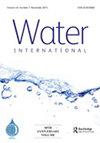中国大陆的海绵城市建设能否将流域水文恢复到不发达的状态?
IF 1.5
4区 环境科学与生态学
Q3 ENGINEERING, CIVIL
引用次数: 1
摘要
摘要:本文探讨了海绵城市建设能否通过径流深度恢复流域水文状况。根据年降雨量体积捕获比(VCRAR)计算年径流深度,并与未开发和海绵城市建设前进行比较。研究结果表明:现行的雨水来源控制标准有利于中国的水文恢复。但12.9%的地区海绵城市建设前与未开发地区差距较大。本文提出的VCRAR调整建议有利于流域水文的恢复。本文章由计算机程序翻译,如有差异,请以英文原文为准。
Can sponge city construction in mainland China restore the river basin hydrology to an undeveloped state?
ABSTRACT This paper explores whether the sponge city construction implemented in China can restore the hydrological condition of the river basins through runoff depth. The annual runoff depth was calculated based on the volume capture ratio of annual rainfall (VCRAR) and compared with undeveloped and before sponge city construction. The results conclude as follows: the current rainwater source control standard benefits the hydrology recovery in China. But the difference between before sponge city construction and undeveloped is large in 12.9% of the regions. The adjustment recommendations of the VCRAR proposed in this paper are favourable to restoring the river basin hydrology.
求助全文
通过发布文献求助,成功后即可免费获取论文全文。
去求助
来源期刊

Water International
工程技术-工程:土木
CiteScore
4.40
自引率
7.70%
发文量
58
审稿时长
6-12 weeks
期刊介绍:
Water International is the official journal of the International Water Resources Association (IWRA), founded in 1972 to serve as an international gateway to the people, ideas and networks that are critical to the sustainable management of water resources around the world. Water International''s articles, state-of-the-art reviews, technical notes and other matter are policy-relevant and aimed at communicating in-depth knowledge to a multidisciplinary and international community. Water International publishes both individual contributions and thematic special issues and sections on cutting edge issues.
All individual manuscript submissions are subject to initial appraisal and peer review by the Deputy Editor in Chief and the Associate Editors, and, if found suitable for further consideration, to peer review by at least one independent, anonymous expert referee. All external peer review is double blind. Thematic issues and sections are handled under comparable procedures by guest editors under the oversight of the Editor in Chief.
 求助内容:
求助内容: 应助结果提醒方式:
应助结果提醒方式:


